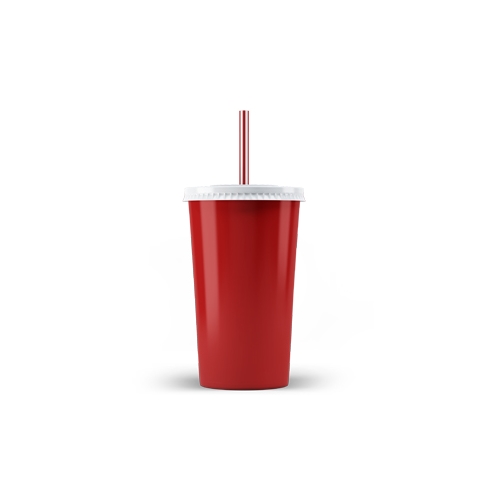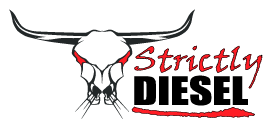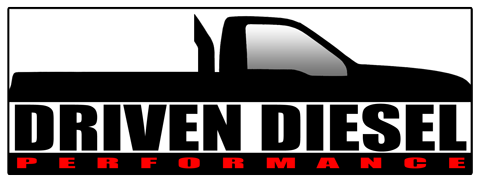 Before I get into further diagnosis, anyone following this procedure with AFTERMARKET INJECTORS needs to be doing so with a pump that is sized correctly. Depending on the injectors, a stock pump may not be enough, and the cause of your low fuel pressure under load may simply be that your pump is too small for your power level. I will have a future article on this, based on data from our flow bench. For now, a good rule of thumb is that a stock pump in a 7.3L can support 180cc injectors with stock nozzles, but larger injectors or 180s with nozzle work will start to see some pressure drop. For the 6.0L crowd, we generally recommend more pump starting with 190cc injectors. If you are running larger injectors than we have recommended here, and still using a stock fuel pump, it is highly likely that you will have solid fuel pressure at idle, and probably in your lower power tunes, but when using a race level tune under heavy throttle you will see the fuel pressure dropping off. If this is the case, you simply need a pump setup that is large enough for your injectors.
Before I get into further diagnosis, anyone following this procedure with AFTERMARKET INJECTORS needs to be doing so with a pump that is sized correctly. Depending on the injectors, a stock pump may not be enough, and the cause of your low fuel pressure under load may simply be that your pump is too small for your power level. I will have a future article on this, based on data from our flow bench. For now, a good rule of thumb is that a stock pump in a 7.3L can support 180cc injectors with stock nozzles, but larger injectors or 180s with nozzle work will start to see some pressure drop. For the 6.0L crowd, we generally recommend more pump starting with 190cc injectors. If you are running larger injectors than we have recommended here, and still using a stock fuel pump, it is highly likely that you will have solid fuel pressure at idle, and probably in your lower power tunes, but when using a race level tune under heavy throttle you will see the fuel pressure dropping off. If this is the case, you simply need a pump setup that is large enough for your injectors.WHEN SUCKING DOESN'T SUCK
So, at this point you should have established that the regulator appears to be working, and the fuel pump is running and has correct voltage...but you still have low fuel pressure (either at idle or under load). Returning to the previous two articles, you need to remember that "pressure requires flow", so low pressure is generally a result of low flow. Since nobody likes to just throw parts (money) at a problem to see what sticks, and you are working under the assumption that your pump is correctly sized and working properly, what else can cause a reduction in flow?
Another analogy I've made many times over the years to get a point across has been the "Drinking Straw" comparison, which applies in a few ways. First, imagine you have your favorite beverage in a nice, fresh convenience store cup. You pull the wrapper off the straw, poke it through the hole in the lid and go for that always satisfying first drink...and get a mouthful of air bubbles and barely any soda...$%@*! You already know what I'm going to say next because this has probably happened to everyone multiple times...the straw is cracked and sucking air, throw it away and get a new one. While this particular issue is not the most common, the same thing can happen in your fuel system. It can be caused by a cracked pickup tube in the tank, or some other type of leak (loose fitting, loose filter, broken pickup screen, etc) in the suction side of the system between the tank and pump inlet. Just like the cracked straw, this leak allows air to be sucked into the fuel stream when the pump is running, which causes less fuel to be picked up and sent to the injectors. Less flow equals less pressure. If this is happening only when the fuel level is below a certain point, you have a problem inside the tank. If it is happening all the time, your problem is either always above the fuel level (inside the tank) or it is outside of the tank.
Using the same cup of soda and a good straw, now imagine that you are right in the middle of washing down your salty french fries when your friend reaches over and pinches your straw closed. That feeling in your cheeks is exactly how your fuel pump feels when something is restricting the suction side of the system. This could be a plugged filter, kinked or pinched hose, plugged pickup screen, pickup tube too close to the bottom of the tank or hose that is too small on a high performance pump. Regardless of the cause, a restriction in the suction side of the fuel system will cause a reduction in fuel volume moving through the pump, and ultimately a drop in fuel pressure.
94-97 7.3L Owners : If you are running an electric fuel system that still uses the fuel tank selector valve, this is a common point of failure that can "pinch your drinking straw" (so to speak). You should pay attention to whether or not the issue exists in just one tank, or both. If both, the selector valve may not be fully switching. If just one tank, it is usually something in the tank or lines for that tank, but it could still be a selector valve issue if you can't find it elsewhere usnig the testing below.
08/12/20 Update: Click HERE (opens in a new window) to see a perfect example of what was described above. This truck came to our shop because another shop had installed an aftermarket fuel tank, then couldn't figure out why the truck suddenly had no power. Can you spot the problem???
DIAGNOSIS IS BUCKETS OF FUN
Testing to determine if the truck has a "Suction Side" problem will generally also tell you if you have a pump functionality problem. We commonly refer to these as "Bucket Tests". The premise is simple, you need to temporarily bypass your entire existing fuel system from the pump inlet back to the tank by connecting your pump inlet to a different source ("bucket") of fuel. In doing so, you eliminate everything between the bottom of your fuel tank pickup to the pump inlet. If you need to drive the truck to verify the concern, the best way to do this is to make your existing fuel tank your "Bucket" by simply connecting a long hose to the inlet of your pump, routing it down the filler neck until it reaches fuel and securing it so it can't fall out. You are still bypassing your current fuel system, but you are pulling the fuel from the same tank you are returning to so you can drive the truck without fear of running out (provided you have enough fuel in the tank). Just make sure the hose is secured so it can't come out while you are driving, and it can't drag on the ground!
If you had a low fuel pressure problem at key-on or idle, and it is suddenly fixed, you know that you need to closely examine the fuel lines from the tank to the pump, and you may need to drop the fuel tank and inspect the pickup tube assembly. It could be as obvious as a broken pickup screen or a loose fitting, or it could be harder to see like a crack in the actual metal tube.
If your low fuel pressure problem is only under load, and you are following the recommendation above for running a long hose from the pump inlet down the filler neck, here are a few things to consider. If you are running a high performance aftermarket pump, you need to use a hose that is the correct size for that pump. Trying to run small hose for this test could restrict the pump and either make the problem worse, or make it appear like the problem is elsewhere. Also, you need to make sure there is adequate fuel in the tank. Dropping a hose into the tank with no pickup foot on the bottom can lead to a situation where the fuel sloshes away from the end of the hose and the pump sucks air. There needs to be enough fuel to keep the end of your test hose covered at all times. Lastly, picking up from the tank this way does add more vertical distance the fuel has to be moved by the pump. If you see what looks like a good improvement, but it isn't perfect, it could be due to the fact that the pump is working a bit harder to move the fuel because of the strange path to the pump. A noticeable improvement is enough indication for me to suggest that you closely check out the fuel system for signs of restriction or leakage.
Regardless of whether you are diagnosing a problem at idle or under load, the bucket test is a worthy method because it gives you immediate feedback. Pulling the fuel through a different line, which bypasses any fittings and filters and the tank pickup assembly, will either fix the problem or it won't. If it fixes the problem, you know where you need to look to make a permanent repair. If it doesn't, there is a very good chance you are dealing with a fuel pump functionality problem, or in very rare cases, something after the pump.
If you have not discovered the source of your "Low Fuel Pressure" by now, there is a very good chance your pump is either under-sized or under-performing. As mentioned before, I'm not a fan of just throwing parts at a problem, so before spending money on a new pump I always recommend running through the tests more than once and making sure you are getting consistent results. If you are certain that you don't have a regulator issue, don't have any kind of restriction or blockage in the suction side of the fuel system, don't have some kind of air leak on the suction side and don't have any kind of wiring issue at the pump, then it may be time to condemn the pump. If it is still under warranty, you may want to contact the manufacturer or distributor and see what they recommend. If it is no longer under warranty, I would suggest giving Strictly Diesel a call to discuss your situation and needs, we would be more than happy to help you get a pump that is right for your truck, whether a direct stock replacement or some larger aftermarket setup for a higher performance application.
I will address some pressure side issues in the next article.

Author: Dennis Schroeder - Co-Owner of Strictly Diesel
Dennis has been Designing, Building and Supporting Aftermarket Fuel Systems for 7.3L and 6.0L Powerstrokes since 2001.


